Two of the Five Hot Jobs for MBA Graduates, according to U.S. News & World Report are “Product Manager” and “Product marketing manager and brand marketing manager.”[1] McKinsey recently highlighted the product management talent dilemma. Strategy + Business has pointed to the importance of, and the general trend towards, stronger product management.
 Whether or not your B2B organization prints “Product Management” business cards, product management is a functional necessity for differentiated products and services. The responsibilities of a Product Manager are carried out by brand managers, marketers, product marketers, business developers, and Product Managers. When accountability for product management is specific to one person, the Product Manager role is to be CEO of one or more offerings. The full burden of being CEO rests on most Product Managers even though the rest of the team that sells, supports, and develops these offerings does not report to them. Controlling no real command structure, Product Managers invariably need to recruit other team members to help them paint fences.
Whether or not your B2B organization prints “Product Management” business cards, product management is a functional necessity for differentiated products and services. The responsibilities of a Product Manager are carried out by brand managers, marketers, product marketers, business developers, and Product Managers. When accountability for product management is specific to one person, the Product Manager role is to be CEO of one or more offerings. The full burden of being CEO rests on most Product Managers even though the rest of the team that sells, supports, and develops these offerings does not report to them. Controlling no real command structure, Product Managers invariably need to recruit other team members to help them paint fences.
Some product management professionals devote themselves primarily to product development and launch, but for many businesses, executing on existing products and services, throughout their product life cycle, is critical to driving operating and financial results. In a previous blog, we explored the role of value management in the innovation process. In this blog we focus on value management for products and services that are already on the market.
 Two Key Product Management Deliverables. A simple way to identify who is in charge of a product or service is to ask who is responsible for delivering:
Two Key Product Management Deliverables. A simple way to identify who is in charge of a product or service is to ask who is responsible for delivering:
- a product or brand plan.
- the vision, content, and drive to execute on the plan and deliver results.
Even if there are fixed delivery dates, a good plan should be agile to capitalize on new opportunities and respond to market changes. Even when a financial reporting period closes, the execution cycle continues into the next year. Product management is a continuous process.
If no one is accountable for a plan and for execution, the organization has a product leadership vacuum. Without leadership, expecting financial performance or growth from the product or service is a hope, not a strategy.
Three Central Elements of Product Management. Having two deliverables sounds straightforward, but being of CEO of a product is easy to say, hard to do. When you search for job descriptions of a Product Manager, the list of qualifications is long, but the primary elements needed to plan and execute effectively are of three types:
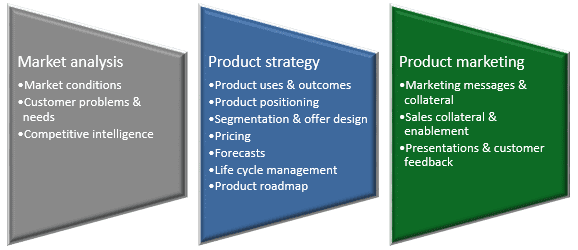
- Good Product Managers are perceptive in their market analysis. They stay current on market conditions. They identify customer problems and needs that their product addresses, characterizing and understanding target customer personae. They are vigilant in gathering competitive intelligence so that they can understand their differentiation.
- Good Product Managers are successful product strategists. That means understanding product uses and the outcomes that customers realize, so that products can be well positioned. A good product strategy is based on good segmentation, so that offers are designed and priced to compete effectively in targeted segments. Robust product forecasts are usually pivotal to the broader business plan. Product Managers focus on life cycle management, planning for the demise and replacement of products in their portfolios. Identifying gaps between customer needs and available products helps to drive innovation and a well-designed product roadmap.
- Product marketing provides Product Managers with the leverage to execute on their plans. Based on good strategy, Product Managers generate and refine content for strong marketing and sales collateral. Product marketers, aligned with their sales teams, use their best content to drive and enable sales performance. Good product marketers spend time with customers themselves, not only presenting to them but gathering their feedback.
Apply the Tools of Value Management. A Product Manager’s job description is complicated. The tools of Value Management provide a focal point that makes Product Managers more effective. Value Management centers Product Managers on the essential connection between product and customer.
A value management framework compels B2B Product Managers to understand their products and services based on the measurable customer outcomes that those products and services deliver. Quantifying value provides insights into the competition and into various customers’ decisions to purchase a product or service. Transforming quantified value into an effective Value Proposition for communication provides central content that supports pricing and sales execution.
There are three Value Management tools that are useful in product management:
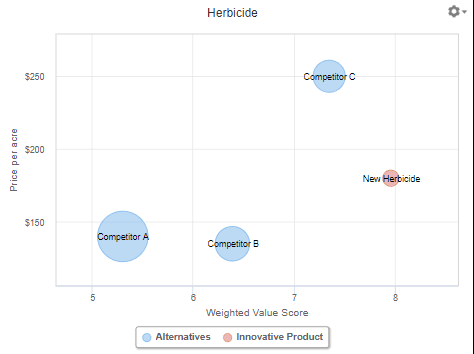 Value Maps. A value map is a two dimensional framework that organizes the key information into Warren Buffett’s two categories: “Price is what you pay, value is what you get.” The usual value map displays product or service prices on the y-axis. Value maps generally show product features/ performance/ benefits or value as a score on the x-axis. A good value map plots a point for each product in the market and uses bubble sizes to represent each product’s market size or market share.
Value Maps. A value map is a two dimensional framework that organizes the key information into Warren Buffett’s two categories: “Price is what you pay, value is what you get.” The usual value map displays product or service prices on the y-axis. Value maps generally show product features/ performance/ benefits or value as a score on the x-axis. A good value map plots a point for each product in the market and uses bubble sizes to represent each product’s market size or market share.
Points in the scatter plot down and to the right in a value map represent better value for money. If the value map’s assessment is a sound one for a given market, then these are the products that should be gaining market share over time. Value maps provide insights into the competitive landscape and product positioning. They help in considering product strategy initiatives and responses.
- Value Models. A value model goes beyond the weighted scoring of a value
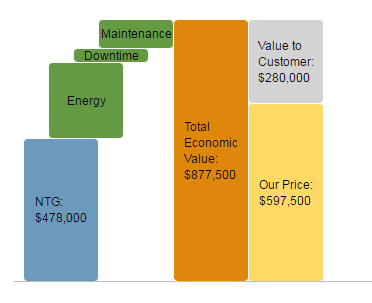 map to dollarize a product’s differentiation compared to a reference competitor. To translate product features and benefits into customer value, a Product Manager needs to understand a customer’s business well enough to analyze the impact of their product on customer revenues and/or costs. When a Product Manager estimates value, they naturally identify the business parameters that drive value, as they assess the quantitative impact of their product on a customer’s financial performance. The resulting value model, when tested and validated, helps a Product Manager confidently set premium prices to capture a portion of the product’s differentiation value.
map to dollarize a product’s differentiation compared to a reference competitor. To translate product features and benefits into customer value, a Product Manager needs to understand a customer’s business well enough to analyze the impact of their product on customer revenues and/or costs. When a Product Manager estimates value, they naturally identify the business parameters that drive value, as they assess the quantitative impact of their product on a customer’s financial performance. The resulting value model, when tested and validated, helps a Product Manager confidently set premium prices to capture a portion of the product’s differentiation value.
The remaining net value to the customer provides the business case for the customer to buy. Estimating value usually generates forks in the road when the Product Manager asks questions about value where the answer is “it depends….” The characteristics of a customer that make a value driver applicable or that change a quantitative impact drive good value-based segmentation. The resulting segmentation helps to design offerings at different price points that capture more customer value as they drive demand.
 Value Propositions. Good math and good analysis are useful in planning and decision-making, but value content supports execution only when value models are transformed into strong Value Propositions. Product marketing is a central element of a good Product Manager’s job. Great Value Propositions provide content to:
Value Propositions. Good math and good analysis are useful in planning and decision-making, but value content supports execution only when value models are transformed into strong Value Propositions. Product marketing is a central element of a good Product Manager’s job. Great Value Propositions provide content to:
- help identify the buyer problems or objectives that you address.
- match your solution to specific buyer problems/objectives, highlighting what your solution has delivered to comparable buyers.
- draw attention to your differentiated ability to deliver these results.
- support a buyer’s business case to buy.
A Product Manager who communicates value internally, in a business language that everyone understands, is more effective in motivating an organization. A Product Manager who communicates value externally to customers generates additional insights into the business outcomes their product delivers, as they help to close deals. A Product Manager who empowers their sales teams to have good value conversations leverages their value insights through tools that enable sales. In the hands of good sales teams, strong Value Propositions evolve from Flexible Case Studies early in the sales cycle to Customer Value Analyses during a customer evaluation to a Shared Business Case to Buy that helps sales teams speed the time to closing.
The benefits of using these value management tools are clear enough. The evidence shows that implementing a value based-pricing strategy improves EBITDA by an average of 8%[2] and that the ROI of investing in value based strategies ranges from 130% to 900%.[3] Product teams who incorporate value into their discussions say that it helps them understand their positioning better and that it makes their decision-making customer-centric. CRM data from B2B organizations adopting value selling show that opportunities where a Value Proposition is used have 5-15% higher win rates and 5-25% higher price outcomes.
5 Disciplines to Embed Value Management in Product Management. Value Management tools are useful. Great Product Managers realize this. But driving Value Management and the customer-centricity it generates into a commercial organization takes more than a volunteer-based, bottoms-up approach. It takes senior management designing, enforcing, and implementing good product management disciplines.[4]
The C-suite should establish common frameworks that provide a common language and structure for value conversations. By embedding Value Management disciplines, they drive higher quality plans and better execution by their product CEOs. Here are five disciplines that great commercial organizations successfully implement. Picking several of them to start is a good way to instigate a Value Management culture.
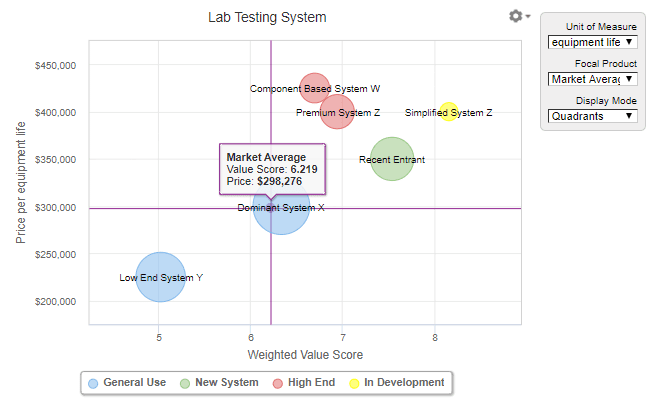 1. Require an Updated Value Map in Every Brand Plan. Building an initial value map for each relevant market for a product drives Product Managers to gather competitive intelligence, starting with prices. Coming up with a list of potential benefits requires Product Managers to understand customer problems and needs. The process of weighting and scoring benefits for different products compels Product Managers to understand their differentiation and their competitor’s differentiation in a more granular way. The end result of a value map is a clear, simple depiction of product positioning.
1. Require an Updated Value Map in Every Brand Plan. Building an initial value map for each relevant market for a product drives Product Managers to gather competitive intelligence, starting with prices. Coming up with a list of potential benefits requires Product Managers to understand customer problems and needs. The process of weighting and scoring benefits for different products compels Product Managers to understand their differentiation and their competitor’s differentiation in a more granular way. The end result of a value map is a clear, simple depiction of product positioning.
Updating the value map has recurring benefits. Updated product sales or market share data usually generates hypotheses: “Why did this system gain market share last year?” “Should you have included other benefits?” “Should you get more customer data to rethink your scores?” The resulting refinements help to revise your understanding of competitors, product positioning, customer problems, and needs. The process of updating the value map also prompts thinking about where your products are in their product life cycle. Seeing the gaps in a market prompts review of the new product road map as well as further development of products already on the market.
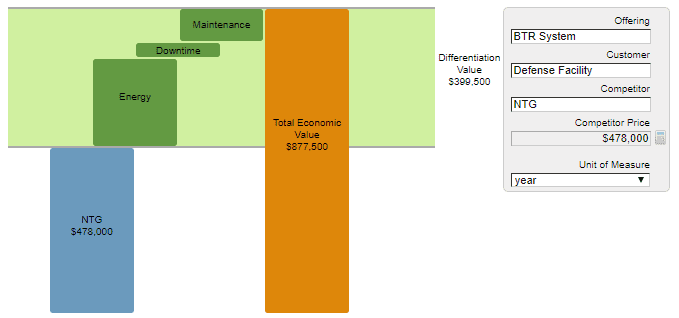 2. Require an Updated Value Model in the Brand Plan for Every Important Product or Service. For important differentiated products and services, taking the further step of requiring an updated value model in each planning cycle has a number of advantages. Building the model forces a Product Manager to deepen their understanding of how the product delivers customer value. Value quantification extends competitive intelligence by driving Product Managers to validate quantitative differences with relevant competitors.
2. Require an Updated Value Model in the Brand Plan for Every Important Product or Service. For important differentiated products and services, taking the further step of requiring an updated value model in each planning cycle has a number of advantages. Building the model forces a Product Manager to deepen their understanding of how the product delivers customer value. Value quantification extends competitive intelligence by driving Product Managers to validate quantitative differences with relevant competitors.
Updating your estimates of differentiated value on a regular basis improves ongoing product management. Refining value models highlights changes in customer problem and needs, as it also provides new insights into customer uses of a product and the resulting customer outcomes. A better understanding of customer problems and product uses sharpens segmentation and product positioning. Revisiting what is valuable to customers provides insights into life cycle management and possible innovations for the road map.
Updating the value model should extend to updating the sales and marketing collateral that comes from it. Part of this discipline is to make sure that the best possible value content is central to product playbooks and other collateral made available for sales. Reassessing value regularly forces Product Managers to recognize new competitors and to identify elements of differentiation that were previously under-recognized and under-marketed.
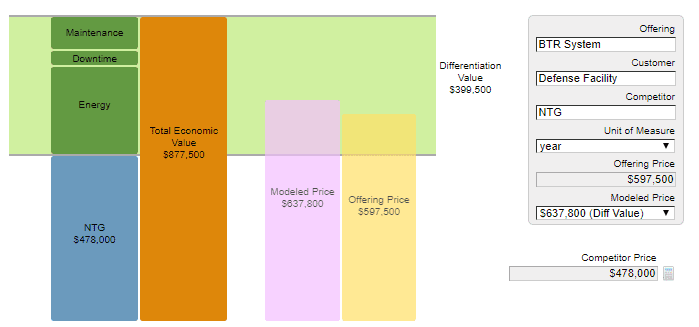 3. Require an Updated Value Model for Every Pricing Review. Product plans and price reviews sometimes coincide, but when they are distinct, price reviews are uniquely situated to reinforce the importance of value. When reasonable value based prices are achieved in closed deals, those customer value conversations provide insights into the validity of the value model, while raising questions about the deals that didn’t close: “Did we lose the business because of price?” “Or did we fail to sell the value?”
3. Require an Updated Value Model for Every Pricing Review. Product plans and price reviews sometimes coincide, but when they are distinct, price reviews are uniquely situated to reinforce the importance of value. When reasonable value based prices are achieved in closed deals, those customer value conversations provide insights into the validity of the value model, while raising questions about the deals that didn’t close: “Did we lose the business because of price?” “Or did we fail to sell the value?”
Updating the value model for price reviews prompts the reconsideration of segments and offer design. Refined value estimates provide a diagnostic that helps identify a need or an opportunity to revise product or service pricing. The changing competitive landscape highlighted in an updated value model helps not only with near-term price setting, but also with positioning and product life cycle strategy. Value and value-based segments can drive how to spend marketing dollars, as they illuminate the plausibility of revenue and profitability forecasts.
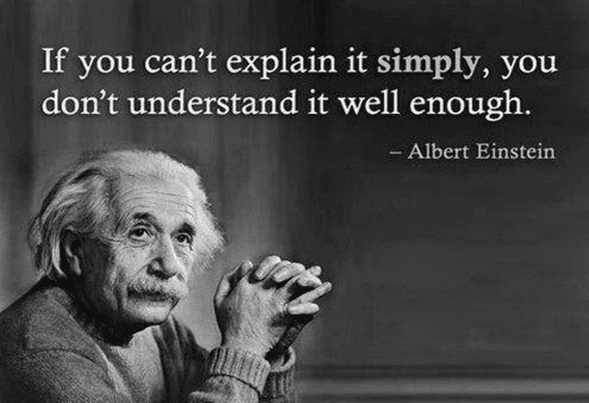 4. Require Internal Value Presentations to be made as if Presenting to Customers. Validated calculators, exact spreadsheets of customer value, and value-based prices represent good outcomes, but often it is tempting for a product team to consider their work done once the math is right. Resist this temptation. Require analytical Product Managers to present their value analyses as if they are explaining what your product does to the buyer’s C-suite. Logical explanation is good. Clarity and simplicity are better. Embedding clear and simple reasons to buy in a narrative or case study about customer success, that includes the math, is best of all. Preferably in words of one syllable.The C-suite and product leadership need to continuously prompt this approach: “I am a customer. Persuade me.” “I am your customer’s CFO. Give me the elevator pitch.” “Math is math but how compelling is the value delivered?” Keeping the customer in the room internally, even if artificially by means of role playing, helps to refocus marketing messages and collateral.
4. Require Internal Value Presentations to be made as if Presenting to Customers. Validated calculators, exact spreadsheets of customer value, and value-based prices represent good outcomes, but often it is tempting for a product team to consider their work done once the math is right. Resist this temptation. Require analytical Product Managers to present their value analyses as if they are explaining what your product does to the buyer’s C-suite. Logical explanation is good. Clarity and simplicity are better. Embedding clear and simple reasons to buy in a narrative or case study about customer success, that includes the math, is best of all. Preferably in words of one syllable.The C-suite and product leadership need to continuously prompt this approach: “I am a customer. Persuade me.” “I am your customer’s CFO. Give me the elevator pitch.” “Math is math but how compelling is the value delivered?” Keeping the customer in the room internally, even if artificially by means of role playing, helps to refocus marketing messages and collateral.
A further step, beyond the internal presentation, is for a Product Manager to pilot their Value Proposition in customer meetings. Direct use generates feedback on the content of the Value Proposition, while testing its usefulness in customer conversations. Product Managers present and engage with customers more effectively, while improving the quality of their marketing and sales collateral. Their experience of how they present the Value Proposition is a first step to get members of the sales team to use similar or adapted value content in their own customer interactions.
 5. Require a Regularly Reviewed Value Proposition for Every Important Product and Service. Drive their Quality and Adoption by Sales and Presales. Great B2B organizations create and sustain a value juggernaut. Everyone, from the CEO to an inside sales rep to a customer support professional, understands and communicates your differentiated value to external audiences. Once Product Managers build out high quality value content, transforming that content into strong Value Propositions is not that hard, but it takes organizational alignment.
5. Require a Regularly Reviewed Value Proposition for Every Important Product and Service. Drive their Quality and Adoption by Sales and Presales. Great B2B organizations create and sustain a value juggernaut. Everyone, from the CEO to an inside sales rep to a customer support professional, understands and communicates your differentiated value to external audiences. Once Product Managers build out high quality value content, transforming that content into strong Value Propositions is not that hard, but it takes organizational alignment.
Here are a few best practices that drive a value selling transformation:
- Get senior management buy-in, both in theory and in practice.
- Enlist sales management and sales mobilizers to test Value Propositions, use them with customers, and generate early success stories.
- Make Product Managers accountable for the quality and usefulness of their Value Proposition as part of their regular review process.
- Empower a 1-3 person Value Office as a SWAT team whose mission it is to drive adoption of value selling. Members of the Value Office coach Product Managers, helping them to improve the content and usability of Value Propositions by sales teams. In driving adoption, they track sales initiatives and are accountable for identifying and driving success.
- Track, recognize and celebrate success.
Product Managers play a pivotal role in this transformation, as they benefit from deeper understanding and better alignment with their customers.
 Value Management for Decision-Making, Pricing and Selling. All great B2B organizations are customer-centric. Innovative businesses benefit by regularly making their product and pricing decisions based on customer value. They only get the full benefit of that customer understanding if they put value selling into practice. Value conversations bring the customer’s business problems into focus, highlighting your differentiation in terms of the outcomes you deliver. This helps improve the quality of product plans and their execution. Product Managers become better Product CEOs, as business results accelerate.
Value Management for Decision-Making, Pricing and Selling. All great B2B organizations are customer-centric. Innovative businesses benefit by regularly making their product and pricing decisions based on customer value. They only get the full benefit of that customer understanding if they put value selling into practice. Value conversations bring the customer’s business problems into focus, highlighting your differentiation in terms of the outcomes you deliver. This helps improve the quality of product plans and their execution. Product Managers become better Product CEOs, as business results accelerate.
To learn more about how to quantify value see:
Can Your Sales Team Sell Your Solution’s Value?
To learn more about how sales teams use Value Propositions see:
Value Propositions for B2B Sales Effectiveness
[1]See page: https://www.usnews.com/education/best-graduate-schools/top-business-schools/articles/hot-jobs-for-mba-graduates
[2]See John Hogan, “Building a World-Class Pricing Capability: Where Does Your Company Stack Up?” Monitor Group Perspectives, 2008.
[3]See Stephan Liozu and Andreas Hinterhuber, eds., The RoI of Pricing, Measuring the Impact and Making the Business Case (Routledge, 2014), especially the chapter by Stephan Liozu, “RoI and the impact of pricing: the state of the profession.”
[4]See Ingo Hennecke, “Implementing a structured pricing strategy approach,” in Andreas Hinterhuber and Stephan M. Liozu, eds. Pricing Strategy Implementation, Translating Pricing Strategy into Results, (Routledge, 2020), pp. 118-125 for a discussion of how to introduce a value based approach to pricing into a B2B enterprise.

